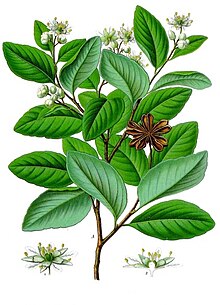| Quillaja | |
|---|---|

| |
| Quillaja saponaria | |
| Scientific classification | |
| Kingdom: | Plantae |
| Clade: | Tracheophytes |
| Clade: | Angiosperms |
| Clade: | Eudicots |
| Clade: | Rosids |
| Order: | Fabales |
| Family: | Quillajaceae |
| Genus: | Quillaja Molina |
| Species | |
|
See text | |

| |
| Distribution of the Quillajaceae | |
| Synonyms | |
|
Fontenellea A.St.-Hil. & Tul. | |
Quillaja is a genus of flowering plants, the only extant genus in the family Quillajaceae with two or three known species. It was once thought to be in the rose family, Rosaceae, but recent research shows it belongs in its own family. The inner bark of the soap bark tree (Q. saponaria) contains saponin, which is a natural soap. Members of this genus are trees that grow to about 25 metres (82 ft).
Species
The species were revised by Federico Luebert in 2014:
| Image | Name | Distribution |
|---|---|---|
 |
Quillaja brasiliensis (A.St.-Hil. & Tul.) Mart. | Brazil |
 |
Quillaja saponaria Molina | central Chile in the forests of La Campana National Park and Cerro La Campana |
References
- Christenhusz, M. J. M. & Byng, J. W. (2016). "The number of known plants species in the world and its annual increase". Phytotaxa. 261 (3): 201–217. doi:10.11646/phytotaxa.261.3.1.
- "Description and images of Quillaja saponaria (Quillay), a native Chilean plant, provided by the supplier of native exotic Chilean seeds". chileflora.com. Retrieved 2014-06-11.
- Luebert, F. (2014). "The taxonomy and distribution of the genus Quillaja Molina (Quillajaceae". Feddes Repertorium. 124 (4): 157–162. doi:10.1002/fedr.201400029.